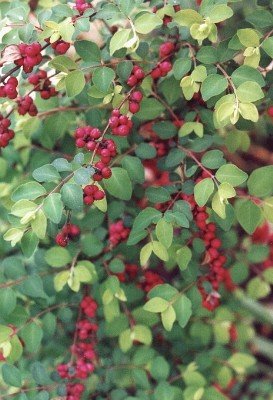Coralberry
by Valerie (May 10, 2002)
 Plants that grow over a wide range tend to have more common names than local isolated species. This is certainly the case with coralberry (Symphoricarpos orbiculatus). Found in the eastern half of the U.S. (and quite common here in Texas), its names include Indian currant, buckbush, devil's shoestring, buckberry, snowberry, snapberry, waxberry, turkey-bush and wolfberry. Some of the names are very descriptive, such as devil's shoestring. The plant produces stolons at just about ground level and these can extend out for a couple feet. They are thin and very tough; just the thing to trip over. Another descriptive name is waxberry because the berries have a strange consistency that really does resemble candle wax. Of course, coralberry refers to the color.
Plants that grow over a wide range tend to have more common names than local isolated species. This is certainly the case with coralberry (Symphoricarpos orbiculatus). Found in the eastern half of the U.S. (and quite common here in Texas), its names include Indian currant, buckbush, devil's shoestring, buckberry, snowberry, snapberry, waxberry, turkey-bush and wolfberry. Some of the names are very descriptive, such as devil's shoestring. The plant produces stolons at just about ground level and these can extend out for a couple feet. They are thin and very tough; just the thing to trip over. Another descriptive name is waxberry because the berries have a strange consistency that really does resemble candle wax. Of course, coralberry refers to the color.
With adequate water, coralberry can grow quite large and the habit of producing long stolons, which sometimes are just underground but mostly are right above, tends to create colonies of the plants. Because the space for it is limited in our garden, I periodically prune the spreading branches as well as remove all the stolons. The main trunk of the plant has gotten rather large over the years, but the branches remain slender. Coralberry is a beautiful bush and grows wild in forested areas. It gets to be about three feet tall and can withstand drought and freezes just fine. It is evergreen, with attractive, delicate oval leaves evenly spaced along the horizontal branches. The color of the leaves ranges from very light green on the branch tips when the leaves are young to dark green when they mature. The flowers are rather nondescript but the berries put on quite a show. They range from bright purplish red to dark dull maroon and form in clusters on the branches. I assume birds eat them because they generally disappear throughout the winter. |